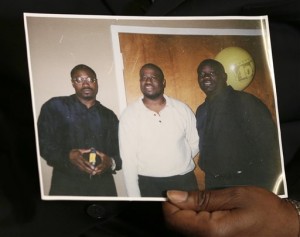Gap remains in video record of fatal US police shooting
NORTH CHARLESTON, South Carolina — Questions persist about the fatal shooting of a black South Carolina motorist after the release of video taken from the car of the white police officer charged in the death.
The dashboard camera footage released by state police on Thursday showed North Charleston Officer Michael Thomas Slager pulling over Walter Scott for a broken brake light last weekend.
READ: US cop charged with murder over shooting black man
The video captures the moments leading up to a shooting that has sparked outrage as the latest example of a white police officer killing an unarmed black man. The shooting itself was captured by an eyewitness on his iPhone and provided the impetus for the officer to be charged with murder and fired. That’s a striking difference from the recent cases in Ferguson, Missouri, and New York City, where white officers were not charged in the deaths of African-Americans, prompting protests and intense debate about police treatment of minorities.
Article continues after this advertisementSaturday’s traffic stop opens routinely as Scott is stopped in a used Mercedes-Benz he had bought days earlier, footage from the patrol car showed. The officer is seen walking toward the driver’s window, requesting Scott’s license and registration. Slager then returns to his cruiser. On the dash cam video, Slager never touches his gun during the stop. He also makes no unreasonable demands or threats.
Article continues after this advertisementThe video also shows Scott beginning to get out of the car, his right hand raised above his head. He then quickly gets back into the car and closes the door. After Slager goes back to his patrol car, minutes later, Scott jumps from his car and runs. Slager chases him.
What’s missing is what happens from when the two men run out of the frame of dashboard video to the time picked up in a bystander’s cellphone video. The cellphone footage starts with Scott getting to his feet and running away, then Slager firing eight shots at the man’s back.

In this April 8, 2015 photo, Anthony Scott holds an undated photo that shows himself, center, and his brothers Walter Scott, left, and Rodney Scott, right, as he talks about Walter at his home near North Charleston, S.C. Walter Scott was killed by a North Charleston police officer after a traffic stop on Saturday, April 4, 2015. The officer, Michael Thomas Slager, has been fired and charged with murder. AP
“It is possible for something to happen in that gap to significantly raise the officer’s perception of risk,” Seth Stoughton, a former police officer and criminal law professor at the University of South Carolina.
Scott was more than $17,500 behind in child support – more than $18,000 with court fees – and had been in jail three times over the issue. He last paid child support in 2012, court records show, and a bench warrant for his arrest was issued in early 2013. His family has said that he might have run because he was behind on payments again and didn’t want to go back to jail..
Police and Slager’s first lawyer initially said the officer fired in self-defense during a scuffle over his department-issued Taser. Within days of Saturday’s encounter, the eyewitness video surfaced and immediately changed perceptions of what had happened.
On Friday, Slager’s mother, Karen Sharpe, told ABC’s “Good Morning America” that she couldn’t believe her son — who loved being an officer and had a baby on the way — would have been involved in the incident. She said she’s taking one day at a time and hasn’t watched the cellphone video that helped bring about Slager’s arrest.
“I just have to let it be and hope God takes care of everybody involved — not only my family but the Scott family because I know they’re grieving just like I’m grieving, so I want them to know that,” she said.
There is almost nothing in Slager’s police personnel file to suggest that his superiors considered him a rogue officer capable of murdering a man during a traffic stop. In the community he served, however, people say this reflects what’s wrong with policing today: Officers nearly always get the last word when citizens complain.
The mostly black neighborhood where the shooting took place is far from unique, said Melvin Tucker, a former FBI agent and police chief in four southern cities who often testifies in police misconduct cases.
Nationwide, training that pushes pre-emptive action, military experience that creates a warzone mindset, and legal system favoring police in misconduct cases all lead to scenarios where officers see the people they serve as enemies, he said.
Slager, 33, could face 30 years to life if convicted on the murder charge.
His file includes a single excessive use-of-force complaint, from 2013: A man said Slager used his stun gun against him without reason. Slager was exonerated and the case closed, even though witnesses told The Associated Press that investigators never followed up with them. Police say they are now looking at that case again amid questions by the man Tased and eyewitnesses who said authorities never questioned them about it.